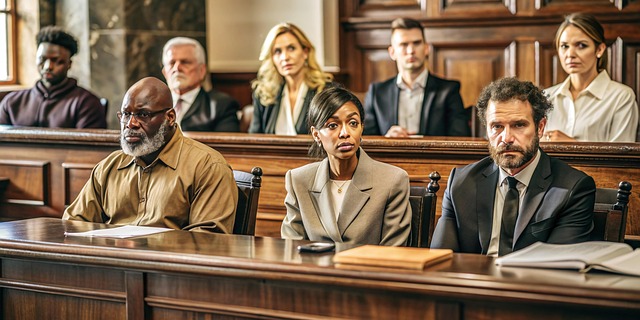Maximizing Witness Testimonies in Personal Injury Trials

In personal injury trials, witnesses are key as they provide firsthand accounts that shape the outco…….
Personal injury trials play a pivotal role in legal systems worldwide, offering a mechanism for individuals to seek justice and compensation following accidents or harm caused by others. This complex process involves a series of steps, from initial claims to final verdicts, and it significantly impacts not only the lives of those involved but also the broader community. In this article, we embark on an in-depth exploration of personal injury trials, unraveling their intricacies, global reach, and evolving nature. By delving into various facets, we aim to equip readers with a comprehensive understanding of this critical aspect of civil justice.
A personal injury trial is a legal process where an individual (the plaintiff) pursues legal action against another person or entity (the defendant) for damages arising from personal harm or property loss suffered due to the defendant’s negligence, intentional acts, or product liability. The primary goal is to establish liability, determine the extent of injuries or losses, and award compensation to the victim.
Key components include:
The concept of personal injury trials has deep roots in common law jurisdictions. The English system, in particular, laid the groundwork for modern personal injury litigation with its development of case law and judicial precedents. Over time, these principles spread globally, adapting to local legal systems and cultural contexts.
In the United States, personal injury law evolved during the 19th and 20th centuries, shaped by industrial growth and changing social norms. The rise of mass litigation in the late 20th century further complexified the landscape, leading to reforms aimed at improving efficiency and access to justice.
Personal injury trials have a profound impact on legal systems worldwide, with many countries adopting principles and procedures influenced by common law traditions. However, distinct cultural and legal variations give rise to unique practices:
| Region | Key Trends |
|---|---|
| North America | High litigation volume, complex medical malpractice cases, emphasis on expert testimony |
| Europe | Strict product liability laws, significant focus on consumer protection, cross-border legal cooperation |
| Asia Pacific | Rapidly growing economies driving product liability and workplace injury claims, increasing awareness of consumer rights |
| Middle East | Influenced by English common law, focusing on traditional personal injury principles with recent reforms |
| Latin America | Varied approaches, some countries adopting more stringent safety regulations, others struggling with legal access |
Personal injury trials have significant economic implications, affecting various sectors:
Investors in the legal sector and insurance industries closely monitor personal injury trends. High-profile cases or changing legal precedents can lead to increased investment or shifts in investment strategies:
Technology has revolutionized personal injury trials, enhancing efficiency and accessibility:
Emerging technologies are poised to further transform the landscape:
Personal injury trials are subject to various policies and regulations that vary by jurisdiction:
| Jurisdiction | Notable Legislation | Key Provisions |
|---|---|---|
| United States (Federal) | Federal Tort Claims Act (FTCA) | Waives sovereign immunity for certain tort claims against the government |
| UK | Civil Liability Act 2005 | Establishes a no-fault system for personal injury claims, focusing on compensation rather than apportioning blame |
| European Union | Directive on Environmental Liability | Imposes strict liability for environmental damage, ensuring accountability |
| Australia | Consumer Law | Protects consumers from unsafe products and unfair business practices |
Personal injury trials face several challenges that impact their effectiveness and accessibility:
1. Legal Aid and Access to Justice Programs: Governments and legal organizations can provide financial assistance and pro bono services to help low-income individuals access the justice system.
2. Simplification of Procedures: Streamlining court processes, adopting technology, and establishing clear guidelines can reduce complexity and speed up trials.
3. Alternative Dispute Resolution (ADR): Encouraging mediation and arbitration as alternatives to trial can help manage caseloads, provide faster resolutions, and reduce legal costs.
4. Expert Witness Reform: Implementing reforms to ensure expert qualifications are rigorously assessed and to promote transparency in their testimony can enhance the reliability of evidence.
A patient (Plaintiff) suffered a severe reaction to a medication prescribed by a hospital (Defendant). The plaintiff filed a medical malpractice suit, alleging negligence in the prescription process. Through expert testimony and comprehensive documentation, the plaintiff’s lawyer demonstrated the defendant’s failure to follow proper protocols. The case settled out of court for a significant sum, highlighting the importance of strict adherence to medical standards.
A consumer purchased a defective electric appliance from a retailer, which led to injuries when it malfunctioned. The consumer sued both the manufacturer and the retailer under European Union product liability directives. The case resulted in a landmark ruling, establishing clear responsibilities for manufacturers and retailers in ensuring product safety.
A worker was severely injured on a construction site due to unsafe working conditions. They filed a claim against the employer, citing negligence in maintaining a safe workplace. The matter proceeded to trial, where the court found in favor of the plaintiff, setting a precedent for holding employers accountable for worker safety.
Personal injury trials are a complex yet essential component of modern legal systems, serving as a critical mechanism for seeking justice and redress. This article has provided a comprehensive overview, from defining key terms to exploring global trends and technological advancements. By understanding these aspects, readers can appreciate the profound impact of personal injury trials on individuals, communities, and societies at large.
As the legal landscape continues to evolve, so too will the methods and strategies employed in personal injury trials. Through ongoing reforms, technological innovation, and international cooperation, the system aims to ensure fairness, accessibility, and accountability for all parties involved.
Q: What is the difference between a personal injury trial and a civil lawsuit?
A: While both involve disputes between private parties, a personal injury trial specifically focuses on claims for physical or emotional harm caused by another’s negligence or intentional acts. Civil lawsuits encompass a broader range of disputes, including breach of contract, property damage, or business torts.
Q: Can I pursue a personal injury claim if the defendant is not insured?
A: Yes, you can still file a claim, but proving liability and securing compensation may be more challenging without insurance coverage. In such cases, assets and personal funds of the defendant may be used to satisfy the judgment.
Q: How long does it typically take for a personal injury trial to conclude?
A: Trial duration varies greatly depending on complexity, jurisdiction, and court workload. Simple cases might resolve within a few months, while complex matters can span several years.
Q: What is the role of expert witnesses in personal injury trials?
A: Expert witnesses provide specialized knowledge and opinions to help judges or juries understand complex issues. They are crucial in cases involving medical, scientific, or technical aspects that lie outside the typical understanding of laypersons.
Q: Are there any reforms being proposed to streamline personal injury trials?
A: Yes, efforts are ongoing worldwide to simplify procedures, reduce backlogs, and enhance accessibility. These include adopting technology, implementing alternative dispute resolution methods, and establishing clear guidelines for expert testimony.

In personal injury trials, witnesses are key as they provide firsthand accounts that shape the outco…….

In a personal injury trial, the pre-trial phase is critical for initiating claims and gathering evid…….

The duration of a personal injury trial varies greatly depending on factors like case complexity, me…….

In a personal injury trial, both parties must navigate key legal concepts like duty of care, causati…….

After a personal injury trial verdict, several post-trial processes ensure justice and enforce the j…….

In a personal injury trial, evidence is critical for establishing liability, damages, and the incide…….

After a car accident, navigating a personal injury trial requires understanding legal rights and pro…….

In personal injury trials, witnesses are crucial for reconstructing accidents, providing diverse per…….

Personal injury trials hinge on decisions made by either juries or judges, each with distinct roles…….